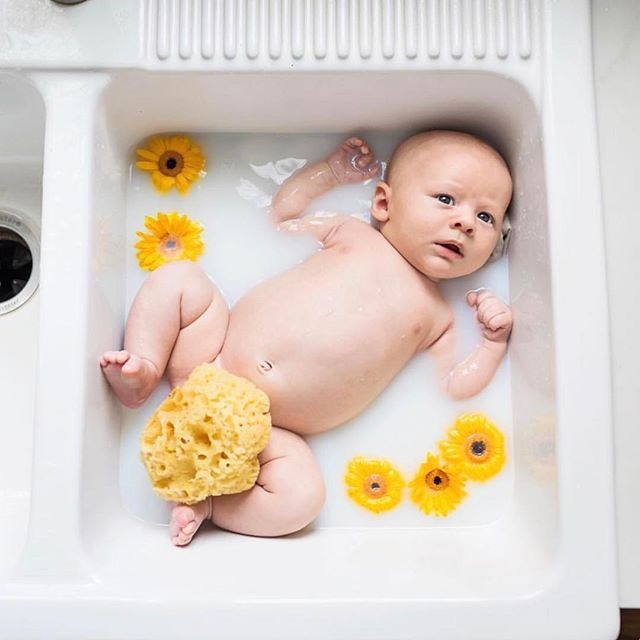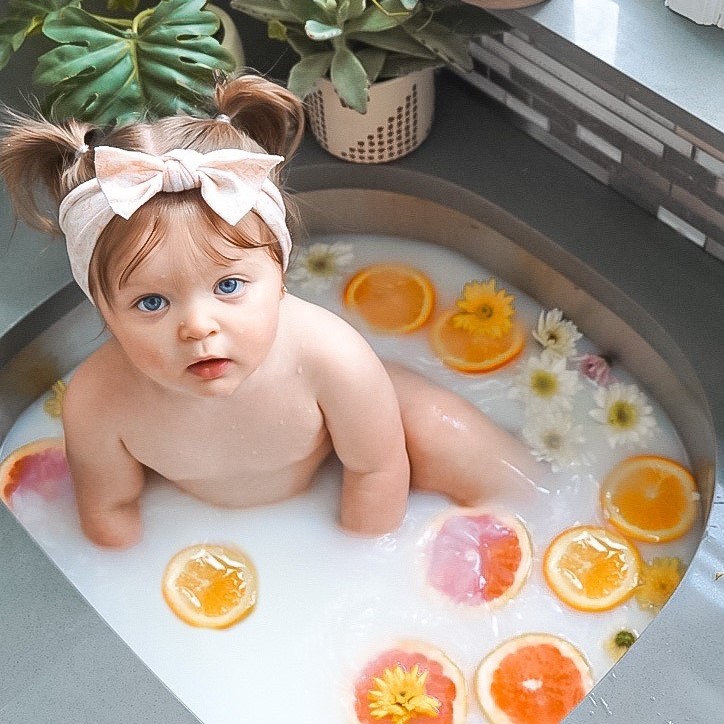What Is a Breast Milk Bath?
A breast milk bath typically involves adding human breast milk to a warm bath. This type of bath aims to harness the natural beneficial properties of breast milk for skin care. The concept may seem unconventional, but it’s grounded in the recognition that breast milk isn’t just for feeding babies; it’s a dynamic biofluid with many uses. Parents and caregivers mix expressed breast milk with bath water to create a soothing soak. This practice has gained popularity for treating various infant skin conditions and promoting overall skin health.
Essential Components of Breast Milk
Breast milk is a rich source of vital nutrients and bioactive compounds. It contains proteins, fats, carbohydrates, and various vitamins and minerals essential for a baby’s development. This complex blend of ingredients contributes to its potent therapeutic effects when used in a bath. In addition to basic nutrition, breast milk has antibodies that fight infection and boost the immune system. These components make a breast milk bath more than just a simple soak; they turn it into a natural remedy for skin ailments.
Key elements that make breast milk beneficial in a bath include:
- Lauric acid: Known for its antimicrobial properties, it helps protect against bacteria and viruses.
- Palmitic acid: Supports skin barrier function and moisture retention.
- Oleic acid: Promotes skin healing and reduces inflammation.
- Lysozyme: An enzyme with antibacterial activity, safeguarding against infection.
- Immunoglobulins: Proteins that play a critical role in immune defense.
These components, among others, provide breast milk baths with their healing and restorative properties, nurturing infant skin effectively.
Therapeutic Properties of Breast Milk Baths

Breast milk baths are renowned for their healing qualities. The fusion of breast milk’s natural components with warm bath water creates a therapeutic soak. This form of bathing can help alleviate common skin issues in infants. It soothes conditions such as diaper rash, eczema, and baby acne. Additionally, it may aid in healing minor cuts and scrapes.
Here are several therapeutic properties of breast milk baths:
- Moisturizing effects: The fats in breast milk provide natural moisturization, leaving baby’s skin soft.
- Anti-inflammatory benefits: These baths can reduce redness and swelling associated with skin irritation.
- Healing properties: The presence of essential fatty acids and vitamins encourages skin regeneration.
- Antibacterial action: Lysozyme and immunoglobulins in breast milk help ward off bacterial infections.
- Soothing comfort: The warm bath combined with breast milk creates a calming environment for infants.
Beyond aiding in skin health, breast milk baths can also offer a bonding experience. Babies often feel relaxed and comforted during the bath, which can strengthen the connection between parent and child. For those exploring natural remedies for infant skin care, a breast milk bath is a gentle and effective option.
How to Prepare a Breast Milk Bath
Preparing a breast milk bath is straightforward and does not require much time. Below is a simple guide to help you set up a beneficial soak for your infant:
- Collect Breast Milk: You will need about 6 to 8 ounces of expressed breast milk. Fresh or thawed milk both work well.
- Fill the Tub: Run warm water into a clean baby bathtub. Ensure the temperature is safe and comfortable for your baby.
- Mix in the Milk: Gently pour the breast milk into the bath water. Stir the water evenly to distribute the milk.
- Test the Water: Always check the water temperature. It should be lukewarm, not hot, to protect your baby’s delicate skin.
- Bathe Your Baby: Place your baby in the tub. Use a soft cup or your hand to pour the milky water over your baby’s skin.
- Duration of Bath: Limit the bath to about 10 minutes to prevent skin wrinkling or irritation.
- Rinse if Needed: Some parents prefer to rinse their baby with fresh water after the bath. Others choose not to, to let the milk’s properties absorb into the skin.
- Pat Dry: Carefully lift your baby out of the tub. Gently pat the skin dry with a soft towel.
A breast milk bath should be a calm and soothing experience for both you and your child. It’s a natural way to nurture your baby’s skin and can be incorporated into your regular bathing routine.
Common Uses for Breast Milk Baths in Infant Care
Breast milk baths offer several applications in infant care. They primarily soothe and improve various skin conditions. Here are common uses for these baths:
- Soothing Diaper Rash: Parents often turn to breast milk baths to calm diaper rash. The natural fats and anti-inflammatory properties provide relief.
- Treating Eczema: The moisturizing effect of breast milk helps hydrate the skin, easing eczema symptoms.
- Clearing Baby Acne: The antibacterial elements of breast milk can help clear up baby acne.
- Healing Cuts and Scrapes: The healing properties support skin repair, making breast milk baths ideal for minor injuries.
- Reducing Cradle Cap: Regular milky baths can help lessen cradle cap flakiness.
- Relieving Dry Skin: The nutrients and fats in breast milk offer deep skin hydration.
Breast milk baths have become a go-to for many parents. They use these natural soaks as a gentle remedy for their infant’s skin issues. Remember, consistency is key. Regular baths can help maintain your baby’s skin health. It’s a safe and nurturing practice that enhances infant care routines.
Skin Conditions That May Benefit from Breast Milk Baths

Breast milk baths have shown promise for a variety of skin issues in infants. Their natural therapeutic properties can soothe and enhance skin health with gentle care. Here we delve into specific conditions that may see improvements with regular breast milk bath treatments.
- Eczema: Babies with eczema often suffer from itchy, dry skin. Breast milk’s natural moisturizing effects can hydrate the skin and ease irritation.
- Diaper Rash: The discomfort of diaper rash can be alleviated by the anti-inflammatory properties in breast milk, offering relief to affected areas.
- Baby Acne: The antibacterial components of breast milk may assist in clearing up baby acne by targeting harmful bacteria.
- Cradle Cap: A regular breast milk bath routine can help in reducing the flakiness associated with cradle cap by keeping the scalp moisturized.
- Minor Cuts and Scrapes: With its healing properties, a breast milk bath can promote repair in the skin, ideal for treating small wounds.
These conditions highlight the scope of breast milk’s versatility as a natural remedy. Parents looking for a soothing solution may find breast milk baths a beneficial addition to their child’s skincare regime. However, always consult with a pediatrician before starting any new treatment to ensure it’s suitable for your baby’s specific condition.
Tips for Maximizing the Benefits of Breast Milk Baths
To get the most out of breast milk baths, consider the following tips:
- Use the Right Amount of Milk: Add about 6 to 8 ounces of breast milk to the bath. This ensures enough concentration to benefit the skin.
- Consistency Is Key: Regular breast milk baths can help maintain the skin’s health. Aim for consistent sessions rather than one-offs for better results.
- Don’t Overdo It: Limit baths to about 10 minutes. Longer exposure may lead to skin irritation or wrinkling.
- Gentle Water Temperature: Use lukewarm water to avoid overheating. This protects your baby’s delicate skin and maximizes comfort.
- Avoid Harsh Soaps: When combining with breast milk, skip the soaps. They can strip the skin of natural oils and reduce milk’s benefits.
- Soft Pat Dry: After the bath, gently pat your baby’s skin with a soft towel. This avoids rubbing off the milk’s nutritious film.
- Observe Your Baby’s Skin: Watch for how your baby’s skin responds and adjust the frequency as needed.
- Consult Your Pediatrician: Before starting regular baths, get advice from a healthcare professional.
By keeping these simple yet effective tips in mind, you can enhance the healing and soothing effects of breast milk baths for your infant’s skin care.
Research and Evidence Supporting Breast Milk Baths

While anecdotes often drive the use of breast milk baths in infant care, scientific research provides backing. Studies have examined the properties of breast milk and their effects on the skin. These investigations reveal why these baths can be helpful for babies.
Some findings support breast milk’s healing impact on diaper rash and eczema. The milk’s natural ingredients help soothe and repair the skin. Research into the fats and antibodies in breast milk shows they can act against bacteria. This action aids in reducing the severity of baby acne and other skin infections.
Further studies have looked at breast milk’s ability to improve the skin’s moisture. Evidence suggests that it helps maintain hydration, making it valuable for dry skin conditions. The vitamins and essential fats found in breast milk play a role in nurturing skin cells.
Experts in pediatrics and dermatology often endorse the use of breast milk for skin health. They base their recommendations on clinical observations and research findings. These professionals recognize the milk’s compounds as safe and effective for certain skin issues.
Parents interested in breast milk baths should review the latest studies. They can also consult with a pediatrician to understand the benefits. Clear evidence may not back every claim, but ongoing research continues to uncover the potential of breast milk in skincare. It’s important to stay up-to-date with new findings to make informed decisions about infant care practices.